Summary
- HashiCorp was created to provide automation tools for organizations adopting multiple clouds.
- HashiCorp offers a unique product portfolio that covers every layer of the modern app stack, with Terraform and Vault being its core products.
- It has a differentiating sales strategy based on a freemium model, starting with an open-source usage before moving to commercialization.
- Its multi-prong strategy utilizing the open-source business model, ecosystem of partners and direct sales, is helping to land, expand and retain customers efficiently.

Just_Super
HashiCorp (NASDAQ:HCP) has been on my list for some time.
This company is not the most popular stock, but its products are essential to the cloud environment we live in today.
This article will dive deep into the fundamentals of the company, and I am sure like me, after reading the deep dive, you will have a better understanding about the company, and you may potentially find the company to be an attractive long-term investment opportunity.
Humble beginnings
HashiCorp was founded by Mitchell Hashimoto and Armon Dadgar.
They met in 2008 in the University of Washington where they worked on a research project to make public cloud technologies available to scientists.
It was not until they graduated that Mitchell founded HashiCorp, and Armon joined as co-founder one year later.
The two founders were at the forefront of the cloud adoption, and as cloud adoption expanded, they envisioned that organizations would need to adopt multiple clouds.
As a result of this adoption of multiple clouds, these organizations would need automation tools that can help them deploy and connect applications to the different cloud environments and on-premises as reliably and consistently as they can.
As a result, the opportunity that HashiCorp is looking to take advantage of is the cloud adoption wave.
When you think about the transition to the cloud, you think of the cloud infrastructure players, Amazon (AMZN), Microsoft (MSFT) and Google (GOOGL).
HashiCorp provides the products that are required to manage this cloud infrastructure, and with the foundational technologies that HashiCorp brings to the table, customers are able to solve the core infrastructure challenges of cloud adoption and thereby, unlock the full potential of modern public and private clouds.
The cloud operating model of HashiCorp provides its customers with consistent workflows and a standardized approach for them to improve the automation of the important processes that are needed to deliver applications to the cloud.
At the end of the day, with its products and solutions, HashiCorp enables customers to accelerate their time to market, lower their cost of operations and improve the security and governance of their infrastructure deployments.
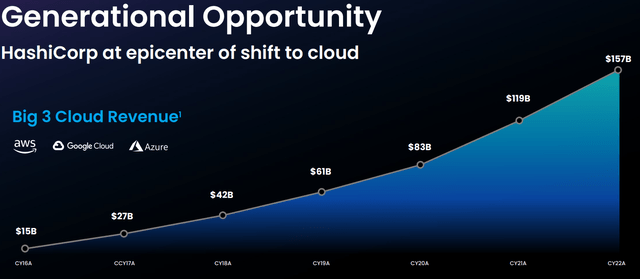
Big 3 cloud revenue (HashiCorp)
HashiCorp Cloud Platform
I think HashiCorp is a very unique company.
Firstly, while competitors are looking to solve just one part of data infrastructure, HashiCorp is focused on very layer of the modern app stack.
As can be seen below, HashiCorp is involved in every layer of the stack, from networking, security, infrastructure to application platforms.
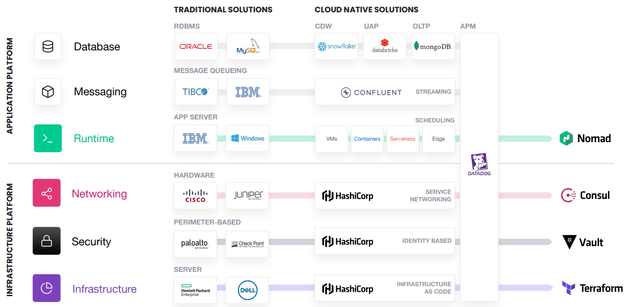
Opportunities at each layer (HashiCorp)
Secondly, HashiCorp has multiple products that can either be used individually or used all together. This is in contrast to competitors that usually have one main product and build the ecosystem from there. When its products are used together as a stack, this helps customers solve larger and more complex problems.
Thirdly, HashiCorp intentionally built its products using an open-core software development model. As a result, all its products are developed as open-source projects, with a large community of users collaborating on its development. On top of the open-source products, HashiCorp sells proprietary commercial software that builds on these open-source products, which comes with enhanced enterprise capabilities.
Today, HashiCorp's products include Terraform, Boundary, Consul, Vault, and Waypoint, amongst others. I am sure we will see HashiCorp release more new products to add to its existing core products.
HashiCorp's software is largely self-managed by customers today. As a result, self-managed offerings make up most of its revenues today. HashiCorp also offers its HashiCorp Cloud Platform to customers, which is its fully managed cloud platform for multiple products.
Over time, the company expects the fully managed business to grow significantly as more customers, including SMB customers, look for fully managed offerings for ease of adoption. Cloud customers can spend significantly less time focused on product deployment and immediately start product adoption, which enables higher retention and expansion. The HashiCorp Cloud Platform also addresses resource and skills gaps, thereby helping customers accelerate their cloud migration.
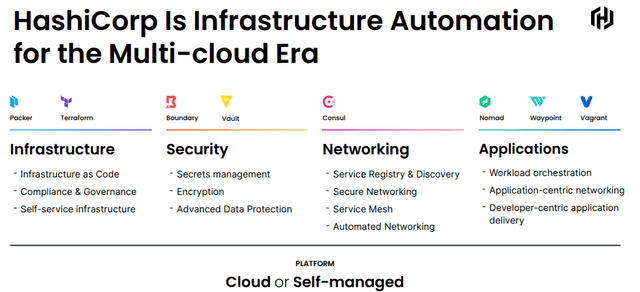
Product portfolio (HashiCorp)
Products of HashiCorp
HashiCorp has a strong portfolio of products that are at different stages of commercialization.
Terraform and Vault are its two core products that are established and currently at scale. Both these products also make up most of its revenues today.
Boundary, Consul, Nomad and Packer are considered emerging products that are in an earlier stage of growth and in the earlier part of the commercialization journey.
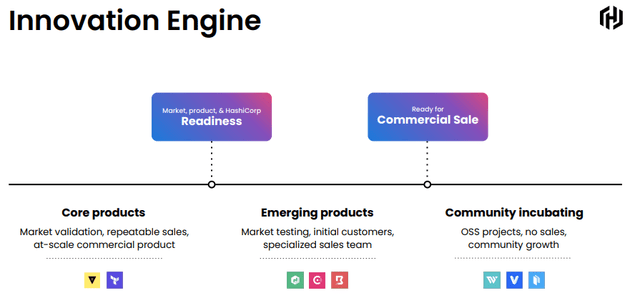
Different commercialization stages (HashiCorp)
I like the framework that HashiCorp uses as it is able to execute on its more established products and grow their scale while at the same time, introduce new products to the market and continue to deliver innovation to customers.
Terraform
Terraform is HashiCorp's infrastructure provisioning product, allowing operators and developers to create and manage infrastructure at scale for any public or private cloud environment.
Terraform transforms the workflow from manual processes to an end-to-end self-service infrastructure automation.
Terraform enables organizations to codify their infrastructure in a simple manner to solve end-to-end infrastructure automation.
Terraform is addressing the emerging cloud infrastructure market, which is expected to grow rapidly from $2.1 billion in 2021 to $12 billion by 2026.
The open-source Terraform product helps solve the technical challenges in provisioning while the commercial offerings, Terraform Cloud and Terraform Enterprise, enable companies to operationalize Terraform.
The pricing of the product is based on the number of workspaces that are managed by HashiCorp's product.
The main uses of Terraform include enabling of multi-cloud consistency, enabling of self-service infrastructure and the enforcement of policy and governance.
Packer
For application teams, as they transition from the development phase to the production phase, there is the need to transform raw source code, application and system configuration and security controls into production worthy artifacts.
This could be a virtual machine, image for an on-premises infrastructure, a Cloud virtual machine image, a container or a serverless package.
The simple explanation for Packer is that it helps customers have a consistent way to automate image builds, creating identical images for multiple platforms from a single source configuration.
Vault
Next up, we have security products.
Vault was designed based on the idea that security needs to be identity based. This is contrast to the traditional approaches of using network perimeters and IP controls.
Vault is used to authenticate applications using a set of extensible plugins.
In simple terms, this means that Vault can be used to support a wide range of platforms, including public cloud providers like Microsoft, application platforms and on-premises systems.
Vault also solves data protection needs as it allows security teams to encrypt and decrypt data to applications and addresses the challenges of key management and cryptography today.
Vault addresses the legacy and emerging security market, and this market is expected to grow to $21 billion by 2026.
The commercial Vault offering is priced based on the number of clients and expands on the open-source capabilities and solves for multi-tenancy of application teams, operational challenges of scale, enhanced security and governance needs of enterprises as well as the deeper sets of advanced data protection capabilities.
Boundary
Boundary is another security product.
Boundary solves the challenges that traditional approaches to Privileged Access Management.
Traditional approaches required users to interact with multiple systems like virtual private networks to access private networks and Privileged Access Management solutions to retrieve credentials and broker access to sensitive systems.
This has resulted in unnecessary additional complexity for users, operations and security teams.
Boundary brings an identity-based approach to Privileged Access Management and all the controls are brought together to just one single system.
This has simplified the jobs of the security and operations teams as they only need to manage a single set of controls based on the logical identify of users and applications.
Consul
Consul is HashiCorp's networking product.
In simple terms, Consul brings all the applications together and forms a central catalog of all the applications, including their metadata and current health status.
You can imagine that this real-time view of this central catalog can facilitate dynamic applications and network automation.
Compared to the fragile and brittle static IPs or host names, Consul’s real-time catalog allows applications and infrastructure to be dynamic and ephemeral.
Consul also enables a modern service mesh architecture, as each application is involved in actively authenticating each connection.
This reduces the risk of a network compromise through lateral attacker movement.
With a focus on identity-based controls, security teams have a smaller number of controls to be managed and this reduces their operational burden.
In addition, Terraform can be integrated with Consul to allow network appliances like firewalls to be automatically updated when the application changes. This integration enables end-to-end automation and enables lower burden on security teams given the focus on identity-based controls.
Consul's networking market is expected to grow to $31 billion by 2026.
The commercial Consul offerings are priced based on the number of server instances used and expands on the open-source capabilities to solve the challenges of multiple teams' collaboration and integrating infrastructure, operational challenges of scale, and the security and governance needs of enterprises.
Application Delivery Products
Nomad, Waypoint and Vagrant are all application delivery products.
Nomad decouples the underlying infrastructure from the application lifecycle, allowing operations teams to manage the infrastructure while providing a self-service interface for developers to manage the application lifecycle.
This solves the problems that traditional virtual machine-based applications bring, which brings an organizational challenge to both the developers and operations teams.
Nomad's applications and workload orchestration market is expected to grow to $9 billion by 2026.
Again, Nomad's commercial version helps solves the challenges of teams being multi-tenant, operational challenges of scale, security and governance needs of enterprises, and a deeper set of functionalities around auto-scaling and capacity management.
Waypoint provides developers with a standardized workflow that is designed to provide developers with a simple experience, while making it highly extensible to enable platform operators to integrate their existing tools and systems.
Last but not least, we have Vagrant.
Vagrant simplifies the development environment as it allows applications teams to start with the actual development more quickly rather than having to spend time setting up the development environments.
This is enabled by Vagrant by creating and configuring development environments that are reproducible and portable, enabling a single and consistent workflow to be used for development.
Sales strategy
I think it is worth explaining more about the sales strategy of HashiCorp because it is not like what most competitors are doing.
It operates somewhat of a freemium model, where up to a certain point, the user is able to use the product for free, and after a certain point, the user is converted to a customer.
As can be seen below, the first step is for users to adopt the open-source usage of its product.
After which, this leads to the first landing product, which is typically Terraform and Vault today.
Thereafter, the sales team expands this customer to the next logical use case and increase adoption and continues to extend further by cross-selling other products.
At the end, the sales team ensures that customer retention remains high by promoting renewals.
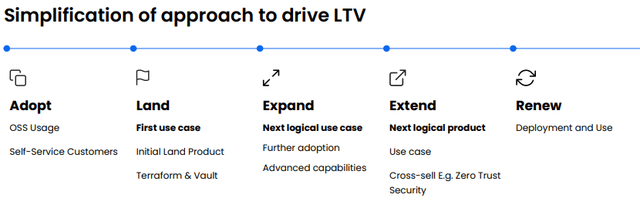
Sales strategy (HashiCorp)
HashiCorp uses the open-source business model.
Unlike other software competitors, since all of HashiCorp's products are developed in open-source, there are a large group of contributors, users that are participating in the development of these products. This community of users can create a strong network effect that later improves adoption of its products and bring in more paid customers.
In addition, the open-source nature of HashiCorp's products means that they are widely distributed and most importantly, free. This means that there is a broad and global use of its products, from smaller startups to large Fortune 100 organizations.
I think that the open-source business model works well for HashiCorp as the community of free users are essentially marketing tools for the company and strong advocates of its products.
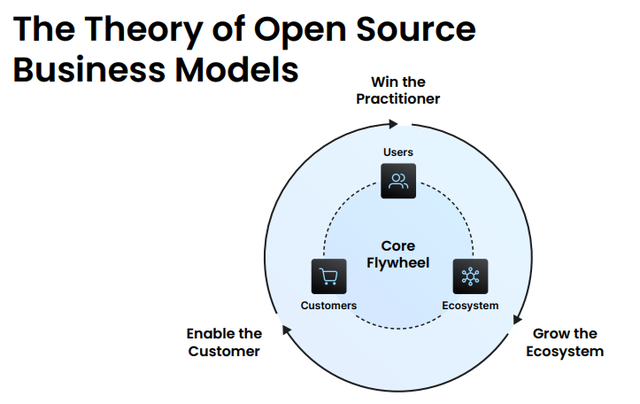
Open-source business models (HashiCorp)
HashiCorp provided some success stories from open-source to commercial scale and I think these stories are crucial to gaining conviction in its business model.
This case study below involves a multinational financial services company that started off with open-source usage of Consul, Packer, Vagrant and Terraform from 2015 to 2016. We saw that the customer's ARR increased 40 times over four years.
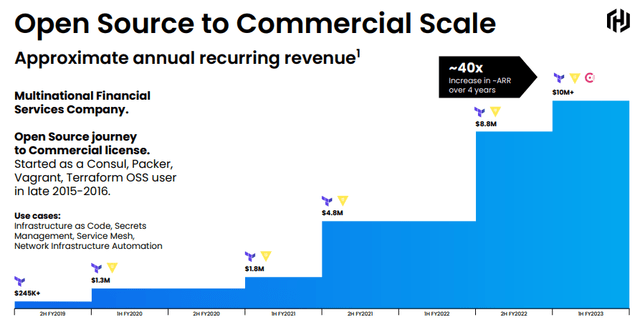
Success story of multinational financial services company 1 (HashiCorp)
Another multinational financial services company that grew ARR by 30 times over the last five years also started with open-source usage in Terraform in 2017 and built its usage and adoption from there.
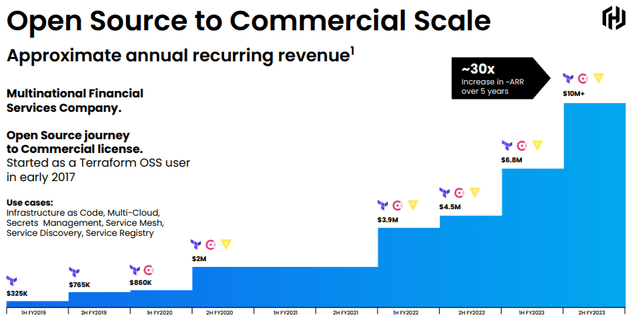
Success story of multinational financial services company 2 (HashiCorp)
Partners
HashiCorp's ecosystem of partners also add to the strength of its sales and software development model.
These partners include cloud service providers, independent software vendors and more. These partners play a role with building direct integrations for mutual customers and thus extends the reach of HashiCorp.
There are also partnerships with systems integrators and resellers to enable successful customer implementations.
I think these partnerships are crucial for HashiCorp because the company needs to ensure that users and customers are able to work within their current infrastructure vendors. This creates additional network effect with its products.
As of January 2023, HashiCorp has more than 2,900 providers and integrations and more than 930 partners. These numbers will almost certainly grow as HashiCorp continues to build the ecosystem and integrate with its growing number of customers.
Strong retention and expansion
HashiCorp's open-source business model, its ecosystem of partners and direct sales create a strong strategy to not just land, but also expand and extend customers.
HashiCorp has one of the best net dollar retention rates in the industry, with the lowest recorded net dollar retention rate at 124% in the last seven quarters.
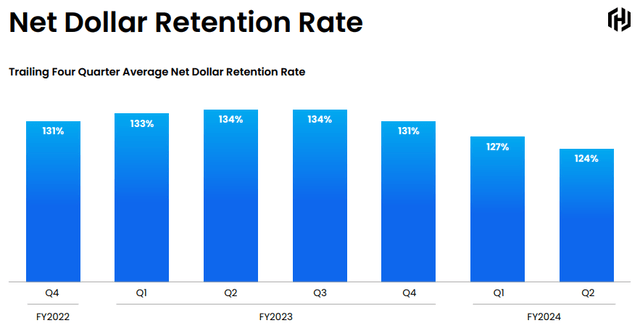
Net dollar retention rate (HashiCorp)
This highlights that its multi-prong strategy utilizing the open-source business model, ecosystem of partners, and direct sales, is not just helping the company build long-term customer relationships with the customer, but also enabling the expansion and extension motion for existing customers after landing them.
As HashiCorp continues to bring in more new users, add more partners to its ecosystem, I see a path to winning more accounts among the Forbes Global 2000.
Valuation
HashiCorp currently trades at 4x 2024 EV/S. Competitors like CyberArk and VMWare are trading at about 7x and 5x 2024 and 2026 EV/S respectively, although CyberArk is growing at a similar 20% CAGR while VMWare is growing at a mid-single digit CAGR.
My one-year price target is $31, which is based on a 7x EV/Sales multiple.
I think that this is justified given that HashiCorp is growing at a faster pace relative to peers.
Conclusion
In the deep dive, we went into the founding story of HashiCorp, introduced the HashiCorp Cloud Platform, and the core products that the company has today and the ones that are emerging and scaling up.
I also elaborated more on the HashiCorp business model, where customers first adopt the open-source usage of the product, and gradually expand and extend their use cases.
It operates somewhat of a freemium model, which has contributed to its success thus far. Its partners play a role with building direct integrations for mutual customers and thus extends the reach of HashiCorp.
Last but not least, HashiCorp's strong expansion and retention rates are a testament to its multi-prong strategy of using the open-source business model, its ecosystem of partners and direct sales to land, expand and extend customers.
Comments